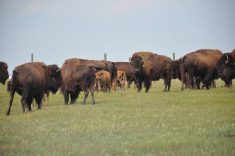DENVER, Colo. – An outbreak of foot-and-mouth disease could cost the United States $10 billion.
Preparing for the next catastrophic foreign animal disease is one of the jobs handled by the departments of agriculture and homeland security, where emergency plans are written and research conducted into better vaccines and improved diagnoses.
“You have to be prepared for the diseases you know and what unknown ones might come,” Jamie Johnson of the Department of Homeland Security (DHS) told the emerging diseases committee, which met Feb. 3 during the National Cattlemen’s Beef Association convention in Denver.
Read Also

Canadian Food Inspection Agency extends chronic wasting disease control program consultation deadline
Date extended for consultation period of changes to CWD program
“We are here to protect the animal agriculture and public health from disease outbreaks. Emerging diseases are here to stay. From a DHS perspective, we want to be prepared to counter those emerging diseases.”
The foot-and-mouth outbreak in South Korea and H1N1 influenza in other countries has reinforced the United States’ resolve not to get caught without a plan, said Darrel Styles, senior staff veterinarian with the U.S. Department of Agriculture’s Animal and Plant Health Inspection Service (APHIS).
Among the first steps are communication and public education about fast moving diseases, he added.
“FMD is not a classical zoonotic disease. It is going to be hard to overcome that public perception and that is going to take a lot of messaging and education,” Styles said.
“One small FMD outbreak in this country could be devastating.”
Controlling animal movement in a country as large as the U.S. is daunting. About 625,000 hogs move each day.
“By the time APHIS detects it, 10 percent of our plants will already be contaminated. It is a challenging disease to work with,” he said.
The government develops standard operating procedures and forms crisis plans, but Styles said it is hard to convince policy makers to fund an event that has not happened.
“No matter how well we plan, it will probably be insufficient,” he said.
A unified centre of control is necessary to control animal movement.
Planning includes discussions on how to humanely destroy animals and dispose of carcasses.
The government must also make decisions about compensation. The policy is to pay for destroyed animals, but a fair market value needs to be established.
Planners also don’t know how long it would take to resume trade.
“We can’t anticipate the behaviour of external trading partners. It may have nothing to do with the issue at hand,” Styles said.
Public messages are important and citizens need to hear a consistent message immediately from credible sources. It needs to be in clear language but still convey the scientific facts.
“All you need is the appropriate celebrity who want to grandstand,” said Styles.















